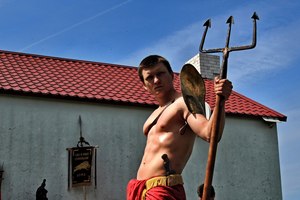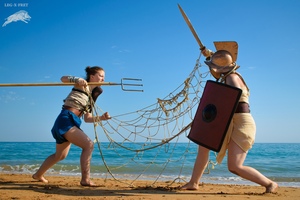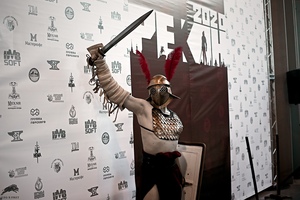Gladiators - literature
This section is dedicated to useful literary materials related to the topic of "Gladiators".
The main reenactment mages of gladiators include various types such as:
And more. Detailed information about assembling equipment sets can be found in the article about gladiators.
Recommended literature on the topic
In Russian:
Arena and Blood - Goroncharovsky.pdf
A comprehensive study of the phenomenon of ancient Roman civilization known as gladiatorial games. Based on a wide range of written, epigraphic, and archaeological sources, the author examines the origins of gladiatorial games and the associated structures, the professional organization, training, and armament of gladiators. It also explores the participation of gladiators in military and political events from the 1st century BCE to the 4th century CE, including the Spartacus uprising. The book provides a detailed analysis of pictorial materials related to the staging of gladiatorial games in the Bosporan Kingdom and their specific characteristics compared to traditional forms of such spectacles in the Roman Empire.
Gladiators-Konstantin Nosov. pdf
Ave, Caesar, morituri te salutant - Hail, Caesar, those who are about to die salute you - this is how gladiators greeted the Roman emperor as they entered the arena. For eight centuries, until the 4th century CE, gladiatorial games were the beloved bloody entertainment of the Romans. The fame of these fighters was akin to the fame of today's Olympians. The book covers the history and development of gladiatorial combat, the hunting and execution of animals, and mock naval battles (naumachiae). It describes the organization and preparation of arenas, types and armaments of gladiators.
The history of gladiatorial combat from its inception to its decline: the first gladiators, their recruitment, training, and armament; gladiator schools, the first amphitheaters and the first arena in Rome, the history of the Colosseum - a grand structure for spectacles; gladiatorial rituals, the hunting of wild animals, and mortal sentences; the history of the most famous gladiator - Spartacus; gladiatorial games in modern times.
In foreign languages:
Gladiators Violence and Spectacle in Ancient Rome - Roger Dunkle.pdf
Answers to questions about gladiatorial combat, such as: What was its origin? Why did it disappear? Who were the gladiators? How did they become gladiators? How was their training conducted? How did the Romans view gladiators? How were gladiatorial shows produced and advertised? What were the different styles of gladiatorial combat? Were there referees in gladiatorial matches? Did every match result in the death of at least one gladiator? Were gladiatorial games merely entertainment, or did they play a significant role in Roman society? What was their political significance?
Bread and spectacles were what the Romans demanded from their emperors, and for over 500 years, spectacles in amphitheaters, circuses, and theaters were the most important forms of entertainment for the masses throughout the Roman Empire. In Rome itself, festive days with magnificent and costly shows lasted for over half a year. The theaters staged comedies and tragedies, pantomimes, and indecent popular plays, while in the arena of the Colosseum, opened in AD 80, gladiators fought in pairs or against wild animals to satisfy the bloodlust of the crowd, and hundreds of thousands of chariot racers gathered in the grandstands of the Great Circus to enjoy thrilling chariot races. The organization of games became an integral part of pre-election campaigns in cities and towns and was increasingly used as a means of consolidating the power of the ruling emperor. Like today's sports stars, the top gladiators, charioteers, and actors were popular heroes, and the power of their universal appeal was recognized and exploited by both politicians and emperors.
Women Gladiators in the Ancient World-Stephen Ross Murray
The ancient Roman historian Dio Cassius recounts events in which women performed in Roman arenas in his book "Roman History." While Priscus and Verus were granted freedom after their fight in the arena, Missio was rewarded by an Amazon and an Achilles, and they were allowed to return to the gladiator school to fight another day. It is debatable whether the owner of the tomb on Great Dover Street proposed by the scholars of the London Museum is a female gladiator. Some researchers also believe that this woman could only be a fan of gladiatorial games. Others claim that she was a disciple of the popular Egyptian cult devoted to the companion of Anubis, Isis. So, was the woman on Great Dover Street a gladiator? Unfortunately, the definitive answer to this question is unknown. What is certain is that women fought in the ancient Roman arena, likely died, and were part of one of the most enduring images of the ancient world: THE GLADIATOR.

 Gallery
Gallery











